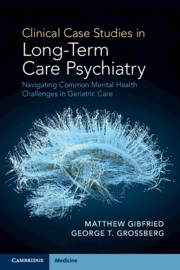 Clinical Case Studies in Long-Term Care Psychiatry
Clinical Case Studies in Long-Term Care Psychiatry Major Depressive Disorder with Psychosis
Published online by Cambridge University Press: 31 October 2024
Those with depression with psychosis meet the criteria for diagnosis of depression but also experience psychotic symptoms. When individuals with major depressive disorder (MDD) experience delusions, hallucinations, or catatonic symptoms, it is referred to as MDD with psychotic psychosis, also known as psychotic depression. The nature of the psychosis in those with depression is usually mood-congruent somatic, pessimistic, or guilt-related delusions. It is crucial for healthcare providers to diagnose psychotic depression early due to its high risk of suicide and poor response to antidepressant treatment alone. Additional antipsychotic medication is typically necessary, in addition to the antidepressant, for an effective response. Electroconvulsive therapy is more commonly used in those with severe depression with suicidality, catatonia, and those with psychotic depression. Studies have shown a response rate of 70-90% with electroconvulsive therapy in those with severe depression.
To save this book to your Kindle, first ensure [email protected] is added to your Approved Personal Document E-mail List under your Personal Document Settings on the Manage Your Content and Devices page of your Amazon account. Then enter the ‘name’ part of your Kindle email address below. Find out more about saving to your Kindle.
Note you can select to save to either the @free.kindle.com or @kindle.com variations. ‘@free.kindle.com’ emails are free but can only be saved to your device when it is connected to wi-fi. ‘@kindle.com’ emails can be delivered even when you are not connected to wi-fi, but note that service fees apply.
Find out more about the Kindle Personal Document Service.
To save content items to your account, please confirm that you agree to abide by our usage policies. If this is the first time you use this feature, you will be asked to authorise Cambridge Core to connect with your account. Find out more about saving content to Dropbox.
To save content items to your account, please confirm that you agree to abide by our usage policies. If this is the first time you use this feature, you will be asked to authorise Cambridge Core to connect with your account. Find out more about saving content to Google Drive.